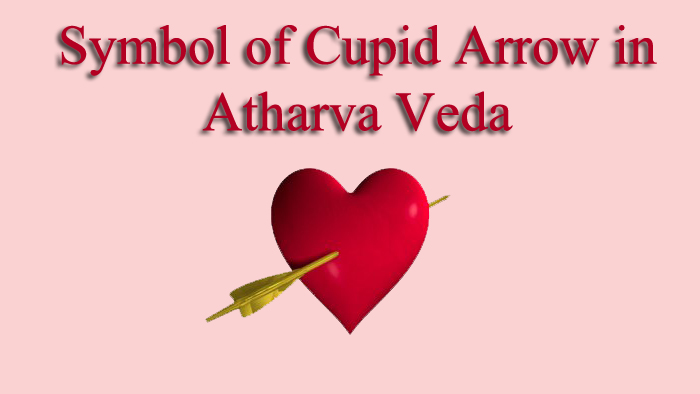Symbol of Cupid Arrow in Atharva Veda

During Valentine Day and other occasions, girls and women are sent cards with the picture of an arrow piercing the heart of a woman. Though many of us are familiar with such Greeting Cards, a lot of people don’t know this symbol has come from the Atharva Veda. Throughout Sanskrit literature we read Manmathan, God Of Love, shooting five arrows made up of flowers to pierce the heart of a lover. We see it first in the Vedas at the earliest time. The concept of Cupid’s arrow has traveled to different parts of the world from India.
Hindus scored many firsts in the world: First Grammar book in the world—Ashtadyaye of Panini, First Sex Manual—Kama Sutra of Vatsyayana, First Dictionary of Synonyms—Amarakosham of Amarasimhan, First religious Book – Rig Veda, First Maths Book with Pythagoras Theorem, etc by Bodhayana, First Logic Book. I can keep on adding over 100 Firsts. But that is beyond the scope of this article.
Read the Atharva Veda Mantra given below and note the words Heart, Arrow, etc.
Charm to arouse the passionate love of a woman.
1. May (love), the disquieter, disquiet thee; do not hold out upon thy bed! With the terrible arrow of Kâma (love) do I pierce thee in the heart.
2. The arrow, winged with longing, barbed with love, whose shaft is undeviating desire, with that, well-aimed, Kâma shall pierce thee in the heart!
3. With that well-aimed arrow of Kâma which parches the spleen, whose plume flies forward, which burns up, do I pierce thee in the heart.
4. Consumed by burning ardor, with a parched mouth, do thou (woman) come to me, pliant, (thy) pride laid aside, mine alone, speaking sweetly and to be devoted!
5. I drive thee with a goad from thy mother and thy father so that thou shalt be in my power, shalt come up to my wish.
6. All her thoughts do ye, O Mitra and Varuna, drive out of her! Then, having deprived her of her will put her into my power alone!
Charm to secure the love of a woman.
1. As the wind tears this grass from the surface of the earth, thus do I tear thy soul, so that thou, woman, shalt love, shalt is not averse to me!
2. If ye, O two Asvins, shall unite and bring together the loving pair-united are the fortunes of, both of you (lovers), united the thoughts, united the purposes!
3. When birds desire to chirp, lustily desire to chirp, may my call go there, as an arrow-point upon the shaft!
4. What is within shall be without, what is without shall be within! Take captive, O herb, the soul of the maidens endowed with every charm!
5. Longing for a husband this woman hath come, I have come longing for a wife, As a loudly neighing horse, I have attained to my good fortune!
(Translation by Maurice Bloomfield, the Year 1897).
The Egyptian ‘Mantra’:
Egyptian God Thoth had a skill in magic. Thoth knew magic spells. It was known that he possessed spells such as this one, which was cast to ensure that one’s love was returned: “should she drink, eat or sleep with anyone else, I shall cast upon her ear, I shall cast a spell upon her breath, I shall cast a spell upon her three physical apertures; but in particular I shall cast a spell upon her vulva, which I wish to penetrate until she comes to me and until I know what is in her heart, what she has been doing, what she is thinking of now, immediately, immediately’ (National Library, Paris, Greek Manuscript, IV 147-153).
AC Das View
A.C. Das showed that the Egyptian religion has a close similarity with the worship of gods –Siva, Kama, and Kalaratri. He thought it is probable that the Egyptians had the knowledge of a god equivalent to Brahma ( AC Das –Rig Vedic India, Vol. II, Ch. XII). Das believed that the Egyptians migrated from the Pandyan Kingdom in the transition from the Vedic to the Puranic periods.






